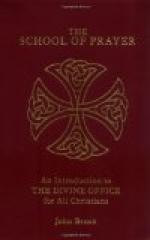Rubrics. The responsories, as a rule, are said after each lesson of Matins. When the Te Deum is said after the ninth lesson, there are only eight responsories. At the end of the third, sixth and eighth lesson the Gloria Patri with a repetition of part of the responsory is said. It is said in the second responsory in offices of three lessons only. In Passiontide the Gloria Patri is not said, but the responsory is repeated ab initio. In the Requiem Office Gloria Patri is replaced by “requiem aeternam.” In the Sundays of Advent, Sundays after Septuagesima until Palm Sunday, and in the triduum before Easter, there are nine responsories recited.
Perhaps an explanation of the rubric may not be useless. The asterisk (*) indicates the part which should be repeated first after the verse and immediately after the Gloria Patri. The Gloria Patri should be said to include the word sancto, and sicut erat should not be said. Some responsories have two or three asterisks, and then the repetitions should be made from one asterisk to another and not as far as the verse ending. Examples may be seen in the responsories for the first Sunday of Advent and in the Libera nos of the Requiem Office. The responsories of the Requiem Office—which is almost the only Office which missionary priests have an opportunity of reciting in choir—are highly praised for their beauty of thought and expression. They were compiled by Maurice de Sully (circa 1196), Bishop of Paris.
Symbolism of the Rubric. The responsories are placed after the lessons, the old writers on liturgy say, to excite attention and devotion, to thank God for the instruction given in the lessons, to make us realise and practise what has been read and to teach us that “Blessed are they who hear the word of God and keep it.” Again, those writers knew why the chanter said only one verse and the worshippers replied in chorus—to show that all their souls were united and free from schism.
Te Deum (Title XXXI.). Author. In the Breviary prior to the reform of Pius X., this hymn was printed under the words “Hymnus SS. Ambrosii et Augustini.” However, “no one thinks now of attributing this canto to either St. Ambrose or St. Augustine” (Battifol, op. cit., p. 110). Formerly, it was piously believed to have been composed and sung by these saints on the evening of Augustine’s baptism. The question of the authorship of this hymn has led to much study and much controversy. Some scholars attribute it to St. Hilary, others to Sisebut, a Benedictine; others to Nicetas, Bishop of Treves, in the year 527. To-day, the opinion of the learned Benedictine, Dom. Morin—who follows the readings of the Irish manuscripts—that the hymn was written by Nicetas of Remesiana (circa 400 A.D.), is the most probable. This opinion has been criticised by several Continental scholars (V. Cath. Encly., art. “Te Deum").




